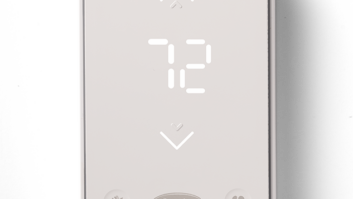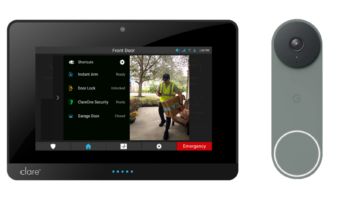Five months after proving that a thermostat could not only cool, but be “cool,” Nest Labs Inc. has added several new features to improve the functionality of its Nest Learning Thermostat.

The Nest Learning Thermostat in Airwave mode
The new capabilities include an Energy History view that shows people exactly when their heating and cooling systems run throughout the day. Nest also added a feature called Airwave, which can help homeowners cut energy used needed to cool your house to a desired temperature. These features – as well as several other additions – are bundled with the Nest Learning Thermostat and delivered to existing customers via automatic software updates.
With the new 10-day Energy History, Nest owners can see exactly when – and for how long – their heating or cooling (HVAC) systems turned on and off, whether their energy use increased or decreased compared to the previous week, and the cause of that change (your adjustment, Away, or the weather). According to the company, the thermostat’s visual display makes it easy to see how small adjustments to a schedule can make a big difference. For added convenience, an at-a-glance Energy History View is available on the device itself, while on the Mobile (iOS and Android) and Web apps, you can drill down within a day to see exactly when your system was engaged. Active heating and cooling time periods are conveyed with red (heating) and blue (cooling) lines and bars across a 24-hour timeline.
Nest’s other big feature, called Airwave, takes advantage of remaining cool air in a home’s HVAC ducts to continue cooling the house without using as much energy. After an air conditioner turns off it stays cold for five to 10 minutes. Airwave shortens the amount of time the high-energy chiller runs and instead a home’s energy-efficient fan to push that extra cool air through the home. Nest automatically enables Airwave when the temperature is high and the humidity is low. Airwave can save up to 30 percent of the energy used, the company said.


Top photo Nest’s “at a glance” view on an iPhone, bottom photo: Nest’s energy history screen on an iPhone.
To make it easier to find customers’ favorite features, Nest also made several small changes to the user interface on the Nest device and mobile apps. For example, Range Mode, which toggles automatically between heating and cooling and is particularly useful in moderate climates, is now only one click away in the Nest Learning Thermostat’s Heating/Cooling menu.
Nest noted that research shows that most customers install Nest themselves, and three out of four DIYers install Nest in less than 30 minutes. In addition, the company’s survey indicated that 99 percent of Nest DIYers would install Nest themselves again. To make installation even easier, Nest has revamped the press connectors on the backplate, moving them to the outer edge. And new custom screws also have been engineered to work without wall anchors, saving people more time.
Nest customers across all 50 U.S. states are already enjoying energy savings, said Tony Fadell, Nest founder and CEO. “In fact, 99 percent of Nest thermostats have a setback schedule – compared to the 10 percent national average – which the EPA says can save 20 percent on heating and cooling costs. With our Nest-exclusive features, Airwave, Auto-Away and the Nest Leaf, we believe there are opportunities for our customers to save much, much more,” he said.
The Nest Learning Thermostat is available now for $249.00 (U.S.) at nest.com.







